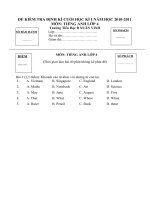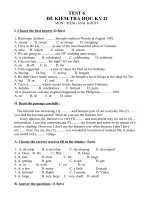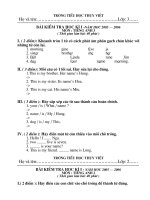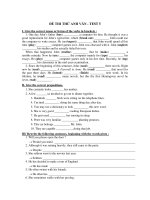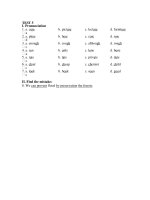Đề thi tiếng anh đề TEST 5
Bạn đang xem bản rút gọn của tài liệu. Xem và tải ngay bản đầy đủ của tài liệu tại đây (80.65 KB, 7 trang )
KỲ THI THPT QUỐC GIA
ĐỀ THỰC HÀNH SỐ 5
Mark the letter A, B, C, or D on your answer sheet to indicate the word whose underlined part
differs from the other three in pronunciation in each of the following questions.
Question 1. A: briefcase
B: purchase
C: suitcase
D: casebook
Question 2. A: bus
B: nose
C: useless
D: horse
Mark the letter A, B, C, or D on your answer sheet to indicate the correct answer to each of the
following questions.
Question 3. The population of India is already nearly ___________ China’s, and with its much higher
birth-rate, will almost certainly become the world’s ___________ populous country within this
century.
A: too large for – very
B: so large as – so
C: large enough – more
D: as large as – most
Question 4. A ___________ of dancers from Beijing is one of the leading attractions in the festival.
A: troupe
B: troop
C: herd
D: packet
Question 5. Some of our volunteers would ___________ for teachers in the event of a strike.
A: fill in
B: work out
C: act up
D: fit in
Question 6. I applied for the job ___________ the off chance, but I didn't seriously expect to get it.
A: on
B: by
C: with
D: for
Question 7. I couldn’t understand what made them all ___________ at the reception.
A: sounding very formally
B: sound so formally
C: to sound so formal
D: sound so formal
Question 8. Despite the long history of the rights of property ownership, there has been ___________
disagreement over what such rights entail.
A: so many
B: quite a few
C: a great deal of
D: a number of
Question 9. The company had sent the advertisement to the newspaper when they realized they’d
mistyped the salary they were offering for the position. Luckily, they ___________ the newspaper to
correct their mistake before they printed it.
A: could have asked B: might have asked C: must have asked
D: were able to ask
Question 10. They agreed to the changes _______________ that they would be introduced gradually.
A: with the conditions
B: for the interpretation
C: by the comprehension
D: on the understanding
Question 11. Next year’s auctions should be advertised until 90 percent of the objects ___________
sold. This year we stopped publishing ads too early.
A: will be
B: will have been
C: have been
D: were
Question 12. It seems that you have to cope with the stresses and strains of the job, ___________?
A: isn’t it
B: doesn’t it
C: haven’t you
D: don’t you
Question 13. The wine ___________ for dinner last night really had a delicious fruity flavor.
A: which we had it B: we had it
C: that had
D: we had
Question 14. Nowadays, quite a few internet courses can offer an effective ___________ to classroom
teaching.
A: alternative
B: alternation
C: alternatively
D: alternating
Question 15. Deep sea diving should always be carried out in pairs. In this way, another source of
oxygen is available ___________ one system fails.
A: only when
B: as if
C: in case
D: otherwise
Question 16. Well, if I ___________it several times, I might still believe he has good intentions.
A: hadn’t heard Dino to be saying
B: didn’t hear Dino say
C: heard not Dino as saying
D: hadn’t heard Dino say
Question 17. This is Mrs. Belinda ___________ book the chapters were prepared and edited perfectly.
A: in which
B: in whose
C: whose
D: from whose
Question 18. Police are warning the public to be on the ___________ for suspicious packages.
A: alert
B: guard
C: alarm
D: care
Question 19. Peter: “Do you mind if I put the television on?” Susan: “___________.”
A: You are welcome
B: No, not in the least
1
C: Not mention it.
D: It’s no matter to me
Question 20. Most of us found the Mayor’s idea ___________ their own candidates for royal honors a
little awkward, but he was right, of course.
A: of having the local people nominate
B: of having the local people to nominate
C: to let the local people for nominating
D: of getting the local people nominate
Question 21. If you refuse to do it, the bosses will have no difficulty ___________ the job.
A: in getting one of those ambitious young men to do
B: getting one of those ambitious young men do
C: with getting one of those ambitious young men do
D: to get one of those ambitious young men to do
Mark the letter A, B, C, or D on your answer sheet to indicate the word that differs from the rest in
the position of the main stress in each of the following questions.
Question 22. A: arcade
B: realize
C: fertile
D: decade
Question 23. A: access
B: advent
C: extent
D: process
Question 24. A: mechanist
B: terrorist
C: interval
D: politics
Mark the letter A, B, C, or D on your answer sheet to indicate the word or phrase that is CLOSEST
in meaning to the underlined part in each of the following questions.
Question 25. In my book, great caution should be exercised in dealing with this matter as it appears to
be more complex.
A: In my retrospection
B: In my subjection C: In my opinion
D: As for my
reading
Question 26. We have to balance the risks of the new strategy against the possible benefits.
A: keep steady
B: stay away
C: compare
D: work out
Question 27. According to the local newspaper, within a year the party had drastically overhauled its
structure.
A: improved
B: appreciated
C: devalued
D: established
Question 28. The students were given complimentary passes for the new movie.
A) inexpensive
B) free
C) expensive
D) good
Question 29. The president's compassion for the refugees caused him to admit a very large number of
them.
A) friendship
B) respect
C) pity
D) hostility
Mark the letter A, B, C, or D on your answer sheet to show the underlined part that needs
correction.
Question 30. We call her as ‘Auntie Flo’, though she is not really any relation to us.
A
B
C
D
Question 31. A light year is the distance that light travels in one year calculated by using the speed of
A
B
C
186,284 miles the second as a base.
D
Question 32. People with exceptionally high intelligence quotients may not be the best employees
A
B
since they become bored of their work unless the job is constantly changing.
C
D
Question 33. George Washington, his portrait appears on the quarter coin and the dollar
A
B
bill, served two terms as president.
C
B
Question 34. Marta being chosen as the most outstanding student of her campus made her parents very
happy.
A
B
C
D
Read the following passage and mark the letter A, B, C, or D on your answer sheet to indicate the
correct word for each of the blanks.
The joys and tribulations of being a pet owner! During our lifetime most of us have some experience
2
of either owning a pet or being in (35) ___________contact with someone who does. Is there such a
thing as “the ideal pet”? If so, what characterizes the ideal pet? Various (36) ___________ influence
one’s choice of pet, from your reasons for getting a pet to your lifestyle. For example, although quite
(37) ___________ pets are relatively cheap to buy, the cost of upkeep can be considerable. Everything
must be (38) ___________ into account, from food and bedding, to vaccinations and veterinary bills.
You must be prepared to (39) ___________ time on your pet, which involves shopping for it, cleaning
and feeding it. Pets can be demanding and a big responsibility. Are you prepared to exercise and (40)
___________ an animal or do you prefer a more independent pet? How much spare room do you
have? Is it right to lock an energetic animal into a detained space? Do you live near a busy road which
may threaten the life of your pet? Pets (41) ___________ as turtles and goldfish can be cheap and
convenient, but if you prefer affectionate pets, a friendly cat or dog would be more (42) ___________.
People get pets for a number of reasons, (43) ___________ com¬pany, security or to teach
responsibility to children. Pets can be affectionate and loyal and an excellent source of company as
long as you know what pet (44) ___________ you and your lifestyle.
Question 35. A: close
B: near
C: tight
D: narrow
Question 36. A: facets
B: points
C: elements
D: factors
Question 37. A: a bit
B: a few
C: a lot
D: a
many
Question 38. A: held
B: taken
C: kept
D: considering
Question 39. A: take
B: occupy
C: spend
D: waste
Question 40. A: housework
B: housekeep
C: housetrain
D: household
Question 41. A: much
B: so
C: such
D: for
Question 42. A: appropriate
B: close-knit
C: likely
D: comfortable
Question 43. A: in
B: for
C: with
D: by
Question 44. A: matches
B: fits with
C: attaches to
D: suits
Read the following passage and mark the letter A, B, C, or D on your answer sheet to indicate the
correct answer to each of the questions
Today, like most other kinds of theater and music, the musical drama of opera enjoys a myriad
of different forms and interpretations. Operas can exhibit both comical moods as well as the most
tragic ones while the actors may be of the highest caliber or simply part-time novices. But it has not
always been this way. Since its inception in Italy around the year 1600, the opera has experienced a
number of shifts and trends. In the beginning, it was heavily influenced by classical Greek drama and
attempted to adhere to its heroic subject matter and theme. Yet, by the eighteenth century, two distinct
forms were beginning to branch out from the original operatic base in Italy. Italian audiences were able
to witness two fundamental styles: the opera seria and the opera buffa. Their distinct styles reflected
the social mentality of the era and its ability to morph and grow in a new direction, which later
influenced further alterations in modern opera.
The first half of the eighteenth century was dominated by the opera seria, which most closely
resembled the earliest form of the opera. Its characteristics were heavily influenced by the
Enlightenment, a period in Europe which put human reason at the forefront of thought. In turn, clarity
and structure became the foundation of the opera seria. In many ways, simplicity and rational thought,
which were further major characteristics of the opera seria, go hand in hand. It eschewed imagination
and improvisation in favor of familiar storylines, most often Greek, which was easier on the audience
and did not tax their mental capacities too much. However, some operagoers felt slighted by the fact
that the operas failed to challenge them, and though it remained a popular form of entertainment, it
displayed a number of other limitations.
Some members of the audience found further difficulties with the opera seria. First, the organization of
the opera never deviated from the usual norm. It was always composed of three acts, and, within each
act were its fundamental components: the recitatives and the arias. Recitatives are the singing of the
cast, which pushes the action of the opera forward. Arias usually followed as a climax and revealed the
emotion or internal conflict of the actors. The main issue was that such a rigid structure made the opera
3
bland and at times predictable. If there had been more flexibility, the operas would have been more
vivid and alive, yet the composers were bound by the predominant philosophical constraints of the
early 1700s. The stage, then, was ripe for change in the form of the opera buffa, which was beginning
to manifest itself within the opera seria itself through the intermezzo.
The intermezzo was already an integral part of the opera seria in that it was a short performance break
between acts and was less predictable than the major production. Over time, the style of the intermezzo
caught on and was eventually put on separately, eventually being dubbed the opera buffa. This type of
opera was characterized by a light, even comic, motif. More importantly, it was less constrained and
displayed elements of free emotion and subject matter that mirrored everyday life, not, for example,
heroes from Greek tragedies. Further, music began to play a greater role in the opera, was spontaneous,
and often mirrored the emotions of the characters. Because the themes were more true to life, the
audience could relate more closely with the opera buffa. As it developed, the opera buffa also began to
take on more serious subject matter yet retained its free flowing manner.
By the late 1700s, the influence of the Enlightenment was beginning to lose its luster, and the
two predominant forms of opera began to merge into one. The opera seria started to display more
elasticity in its form and structure and even included some dancing in its performances. Likewise, the
opera buffa began to engage in more sophisticated themes. By the end of the century, even the most
sensitive opera enthusiast could hardly distinguish between the two. More importantly, as each form
changed, they were able to provide the audience with the best of both worlds and a more complete
opera experience, as they were composed with intellectual integrity, stimulation sprinkled with
lightheartedness, and humor. From this, the modern form of opera was born.
Question 45. The phrase "a myriad of" in the passage is closest in meaning to____________.
A: a very large number of
B: a majority of
C: an enormous amount of
D: a several of
Question 46. According to paragraph 1, two forms in eighteenth-century Italian opera arose
because____________.
A: most opera enthusiasts were demanding a more flexible, exciting style
B: it was heavily grounded and influenced by classical domestic drama
C: traditional themes of heroism were enjoyed by the regular audience
D: the way people thought was beginning both to develop and change
Question 47. The author discusses the Enlightenment in paragraph 2 in order to____________.
A: contrast the structure of the opera seria with that of the opera buffa
B: indicate what was most responsible for the traits of the opera seria
C: note that though it was a major social influence, it affected the opera little
D: discuss how it was the pinnacle of intellectual thought in Europe
Question 48. Which of the following can be inferred from paragraph 2 about the opera seria?
A: It failed to reveal a story ambitious enough to make the audience think.
B: It was created by people who were influenced by the Enlightenment.
C: It was too complicated for the average Italian to comprehend completely.
D: It had little connection with the plots or themes of classical Greek drama.
Question 49. The author’s description of the problems with the opera seria mentions all of the
following EXCEPT ____________.
A: The composers were, for the most part, bound by social obligation.
B: It regularly followed the same form of recitatives and arias.
C: The storyline left little surprises for the audience’s benefit.
D: The action and imagination of the opera confused the audience.
Question 50. Which of the following can be inferred about the audience’s reaction to the opera seria?
A: The audiences were most attracted by the recitative singing in the opera seria.
B: A large number of audience members found the opera seria to be quite enjoyable.
C: The majority of the audience frowned upon the content of the opera seria
D: The fact that the opera seria focused on themes from everyday life was respected.
Question 51. The word "integral" in the passage is closest in meaning to____________.
A: prearranged
B: popular
C: essential
D: incidental
4
Question 52. According to paragraph 4, which of the following is true of the opera buffa?
A: Its style and delivery became even more restrained than the opera seria.
B: Its composers avoided music in favor of a more flexible structure.
C: It was born from the intermezzo, which was a part of the opera seria.
D: It was characterized by a serious, heroic motif like the Greek drama.
Question 53. According to paragraph 4, the audience felt more attached to the opera buffa because
____________.
A: it avoided comedy and embraced a more challenging tone
B: it contained a logical structure that was easy to follow
C: it looked to instances from daily life for its subject matter
D: it included dancing and more music in the performances
Question 54. The word "predominant" in the passage is closest in meaning to____________.
A: pre-existent
B: dominant
C: differentiated
D: fascinating
Read the following passage and mark the letter A, B, C, or D on your answer sheet to indicate the
correct answer to each of the questions.
Hurricanes are one of the most destructive natural forces on the face of the planet. By definition, they
are also known as tropical cyclones. They manifest themselves in the warm waters of the Atlantic
Ocean, usually in the form of a low-pressure weather system. Due to minimal, high atmospheric
winds, those near the surface of the water begin to spin and spiral in a counterclockwise direction,
feeding on the heat from the ocean. With increased rotation, more water is absorbed into the system
and is then released in the form of showers and thunderstorms. Once the system becomes stronger and
more defined, and sustained wind speeds eclipse speeds of seventy-five miles per hour, the storm can
then be classified as a true hurricane. They pose the greatest threat to human populations when they
track eastward to the tepid waters of the Gulf of Mexico, where the islands of the Caribbean and the
flats of the southeastern United States lie vulnerable to its path of destruction, which is usually
determined by two major factors: storm surge and movement.
While high winds are commonly associated with the perils of hurricanes, the most destructive factor is
the accompanying storm surge as it strikes land. Still, the torrential rains and heavy winds the
hurricane brings contribute to its storm surge, yet this occurs in a more indirect way than was
previously thought. As the hurricane approaches land, water levels increase and are pushed onto and
through the shoreline, causing major destruction. The size of the surge itself is determined by the slope
of the shore, called the continental shelf, out into the ocean. If the slope is steep, the storm surge will
not be as great as when it is shallower, which causes a more powerful surge due to the fact that the
ocean’s depth is not great enough to absorb the energy and massive amounts of water. In fact, scientists
have pointed out that one cubic yard of it weighs about 1,700 lbs. Millions of cubic yards of surge can
occur from one single storm, which, naturally, causes catastrophic damage.
Another major contributor to the measure of destruction a hurricane causes is its movement. The speed
of a hurricane as it makes landfall and moves across or inland is a major deciding factor upon the
extent of the damage. Fast- moving hurricanes can often seem a blessing to the people and
communities involved because their high speeds mean they will move on and away quickly, so they
will not have a chance to dump as much water on the immediate area. However, lazy storms, and
especially storms that stall on the coastline, become the cyclones of devastation. Because they move so
slowly or even not at all and are able to sit spinning and reenergizing themselves from the ocean,
torrential rains, winds, and flooding increase, and the storm surge becomes a perpetual battering ram of
destruction. However, the power of a hurricane becomes immediately diminished once over land
because it is disconnected from its warm water energy source, but this does not mean it is dead by any
means.
When it comes to hurricanes, direct wind destruction is a secondary worry compared to storm surge,
the speed of the hurricanes’ track, and the flooding that is associated with them. The shallow
continental shelf underlying the Atlantic Ocean and the Gulf of Mexico off of the southeastern United
5
States coupled with the low- lying landmass makes the area a prime region for disaster in the form of
storm surge and flooding. This, along with the fickle nature of hurricanes and the inability of experts
accurately to predict a hurricane’s landfall, adds to the turmoil that hurricanes inflict on the populations
of the areas they hit. Not necessarily wind, but water, remains the worst effect a hurricane can have, as
it is able to flood not only the immediate area where the hurricane strikes but hundreds and hundreds
of miles in any given direction as well, affecting people, homes, and businesses far and wide of its
main path.
Question 55. According to paragraph 1, which of the following is true of hurricanes?
A: They are only able to form in tropical waters near the Equator.
B: Storms are classified as hurricanes when gusts reach 75mph.
C: One of the most defining characteristics of a hurricane is its eye.
D: The lack of winds aloft contributes to the formation of hurricanes.
Question 56. Which of the following can be inferred from paragraph 1 about hurricane formation?
A: They usually tend to twirl and spin in a clockwise direction.
B: They are hardly likely to be present in cool oceanic areas.
C: They are spawned by violent thunderstorms and wind shear.
D: They are fueled by the warm waters of the Pacific Ocean.
Question 57. The word "eclipse" in the passage is closest in meaning to_____________.
A: maintain
B: exceed
C: shadow
D: propel
Question 58. According to paragraph 2, what contributes to the destruction of storm surge?
A: The contour of the ocean floor is a major determiner of its size.
B: The torrential rains contained in a hurricane directly affect the surge.
C: The weight of the water will destroy anything in its immediate path.
D: The size of the waves is a principal factor in the resulting damage.
Question 59. The word "it" in the passage refers to _____________.
A: cubic yard
B: energy
C: water
D: ocean’s depth
Question 60. The author discusses a hurricane’s movement in paragraph 3 in order to_____________.
A: downplay the factors of velocity and directional momentum in a hurricane
B: indicate that slow-moving storms allow people more time to seek safety
C: show that a hurricane’s tracking speed determines the amount of destruction
D: suggest hurricanes are capable of moving in any direction at any time
Question 61. The word "perpetual" in the passage is closest in meaning to_____________.
A: wavering
B: chronic
C: incessant
D: damaging
Question 62. Which of the following is NOT true of the major forces of a hurricane?
A: Fast-moving hurricanes ironically help lessen damages.
B: Flooding is usually much more destructive than winds.
C: All coastlines are affected by its storm surge.
D: Strong winds and rain add to its storm surge.
Question 63. According to paragraph 4, which of the following is true of a hurricane’s winds?
A: No other force of a hurricane can inflict more punishment than wind
B: Low-lying areas are more prone to wind forces than elevated areas.
C: Their destruction is short-lived, unlike the effects of major floods.
D: The direction of the winds, not speed, makes them the most dangerous.
Question 64. Which of the sentences below best expresses the essential information in the highlighted
sentence in the passage?
A: Water levels do the most destruction hundreds of miles inside the hurricane, where the
hurricane affects the most people.
B: Flooding, which causes havoc in a very wide range of areas, is the most destructive factor of
a hurricane.
C: Cities in the direct path of a hurricane suffer the brunt of its power through flooding while
the wind does little damage.
D: Winds and rain damage people, homes, and businesses every time a hurricane strikes a
certain area.
PHẦN TỰ LUẬN:
6
Part I: Finish each of the following sentences in such a way that it means the same as the sentence
printed before it.
Question 65: Mike has never been to the capital before.
> This is the first _____________________________________________ .
Question 66: The football match was put off because of the bad weather.
> Because ___________________________________________________ .
Question 67: Nam is not old enough to join the army.
> Nam is too ________________________________________________ .
Question 68: The manager made all the employees work at the weekend.
> All the employees ___________________________________________ .
Question 69: The bus driver cannot be blamed for the accident in any way.
> In _______________________________________________________ .
Part II: Some people think that human needs for farmland, housing, and industry are more
important that saving land for endangered animals. Do you agree or disagree with this point of
view? Why or why not? Use specific reasons and examples to support your answer. (Write a
paragraph about 140 words)
7

